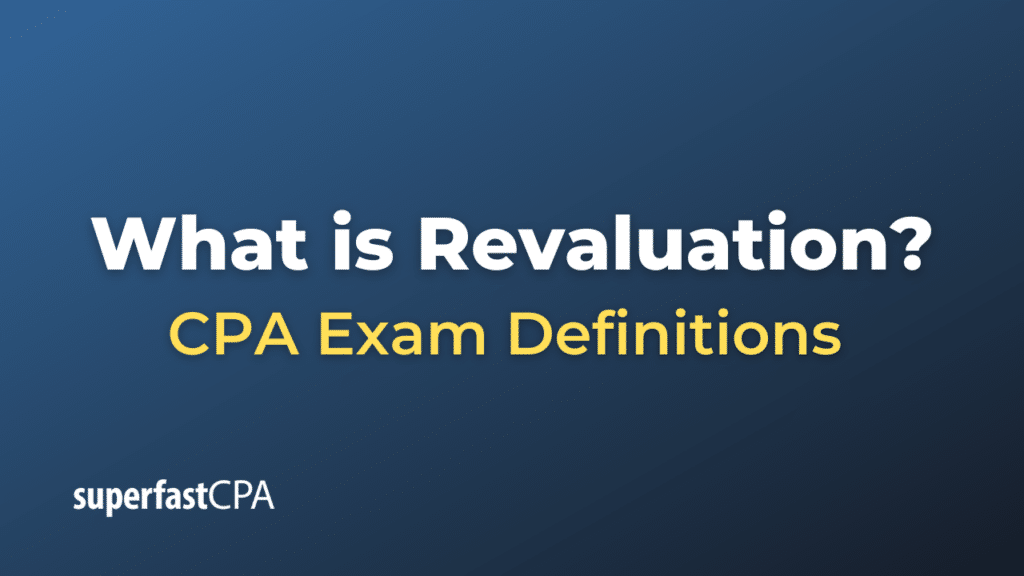Revaluation
Revaluation refers to the adjustment of the value of an asset or liability to reflect its current market value or fair value, rather than its historical cost or book value. This process is commonly applied to fixed assets like land, buildings, and machinery, especially when there’s a significant discrepancy between their market value and book value. Revaluation can also be applied to foreign currency positions or investments, depending on the accounting standards followed and the nature of the assets in question.
There are a few key reasons why companies might engage in the revaluation of assets:
- Fair Presentation: If the current market value of an asset is substantially higher or lower than its book value, revaluing it can give shareholders and other stakeholders a more accurate picture of the company’s financial health.
- Collateral for Loans: A higher asset value can allow a company to secure bigger loans since assets often serve as collateral for loans.
- Depreciation: After revaluation, the depreciation on fixed assets might change because it will be calculated on the revised value.
- Sale of the Asset: If a company plans to sell an asset, revaluing it can give a clearer picture of the expected proceeds from the sale.
- Compliance with Accounting Standards: Some accounting frameworks require or allow for regular revaluations of certain assets.
However, there are some considerations and potential downsides:
- Not a Frequent Adjustment: Under many accounting standards, assets are not revalued on a regular basis. When revaluation is done, it should be done for the entire class of assets (e.g., all buildings), not just one specific asset.
- Subjectivity: The revaluation process can introduce a degree of subjectivity, especially when it’s difficult to determine the current market value of an asset.
- Impact on Financial Ratios: Revaluation can impact various financial ratios, such as return on assets, asset turnover, and others.
- Potential for Reduced Future Earnings: While increasing the value of an asset may also increase its annual depreciation expense, potentially reducing future earnings.
- Tax Implications: Revaluation might have tax implications in certain jurisdictions, especially if the revalued asset is sold.
Example of Revaluation
BrightTech, a technology firm, owns a piece of land that was purchased 5 years ago for $2 million. Over the years, the area around BrightTech’s land has developed rapidly with many tech hubs and offices coming up, leading to an appreciation in land values.
Realizing this, BrightTech decides to revalue the land to reflect its current market value.
Steps:
- Hire an Expert Appraiser: BrightTech hires a real estate appraiser to provide an estimate of the current market value of the land. The appraiser evaluates the land and comparable sales in the area.
- Appraiser’s Report: The appraiser determines and reports that the land’s current market value is $3.5 million.
- Accounting Entries:
- The difference between the original value ($2 million) and the revalued amount ($3.5 million) is $1.5 million. This increase in value is accounted for in BrightTech’s financial statements.
- Debit Land (Asset account): $1.5 million
- Credit Revaluation Surplus (Equity account): $1.5 million
Financial Statement Impact:
- Balance Sheet: The land’s value under “Non-Current Assets” will now show $3.5 million, up from the original $2 million. Simultaneously, the equity section will reflect a “Revaluation Surplus” of $1.5 million, indicating the increase in asset value that doesn’t arise from the company’s operations.
- Income Statement: There’s no immediate impact on the income statement from the revaluation. However, if the land had been a depreciable asset like a building, the future depreciation expense might change based on the new revalued amount.
Operational Considerations:
- Reflects Economic Reality: Stakeholders like shareholders, potential investors, and creditors now have a more accurate representation of BrightTech’s financial position.
- Financing Opportunities: With a higher asset base, BrightTech might be in a position to secure larger loans if needed, using the land as collateral.
- Revaluation Reserve: The $1.5 million isn’t distributable as dividends since it’s not realized profit. It stays as a revaluation surplus in equity until the land is sold or further revalued downward.
- Potential Future Downward Revaluation: If, in subsequent years, the market value of the land decreases, BrightTech might need to downwardly revalue the land, impacting its financial statements negatively.
This example showcases the process and implications of revaluing an asset and how it can provide a more accurate picture of a company’s financial position.













